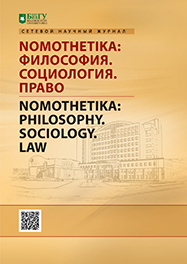Experience of surveying permanent migration center residents and refugees in the Republic of Serbia concerning integration into a new environment
DOI:
https://doi.org/10.18413/2712-746X-2020-45-4-801-809Keywords:
Migrations, Migrant, Refugee, Integration, Survey, Questionnaire, SerbiaAbstract
Migration processes have existed since the beginning of world history and are part of the mechanism of the functioning of society. This is one of the reasons why it is necessary, but it is also complex to investigate these diverse processes, which, as now, turn into a social crisis. Although, with more or less innovation, migration has been studied academically since 1889. there is no consensus on a universal theory of migrations. That would suggest that an interdisciplinary approach to this problem is necessary. Social interaction of migrants with the host society is an indispensable element of any approach to studying this issue, which is the reason for our particular interest in the framework of integration as a mechanism for managing migration. The scientific research that we conducted in all five reception centers for migrants in the Serbia is unique in that the respondents were migrants themselves, which is a rare case in general, and the first of its kind in the Republic of Serbia. We introduced the experience of surveying at the centers of permanent residence of migrants and refugees in the Republic of Serbia. Survey shows the possibility of integration into the host Serbian community, according to the migrants themselves. Thanks to the proposed new type of integration, the author recommends applying an individual approach following the principle of dispersion, which prevents ghettoization – at the initiative of the local community at the local level, within a maximum of one family as a unit of measure. Thus, the role of dispersion is to prevent ghettoization and "parallel life" of migrants and improve interaction with the local population, which is a prerequisite for communication, and consequently for social cohesion.
Downloads
References
Бојовић Б.Б., Бошко И. 2014. Византија. Балкан. Европа: припадност и оностраност. Београд., Изд. Службени гласник (Гласник), 436 с.
Великие евразийские миграции. 2016. Материалы Международной научной конференции ФГБОУ ВО «Калмыцкий государственный университет им. Б.Б. Городовикова». Под ред. Колесник В.И. Изд-во Калмыцкого ун-та, 459 с.
Кондратьева Т.С. 2016. Миграционный кризис в Европе: причины и последствия. В кн.: Проблемы европейской безопасности. Под ред. Пархалина. Выпуск 1. Сер. Европа XXI век. М., 216–229. URL: https://cyberleninka.ru/article/n /migratsionnyy-krizis-v-evrope-prichiny-i-posledstviya (дата обращения: 28.04.2020).
Миграционный кризис в Европе. 2016. Под ред. А.П. Кошкина. Вып. 6. М., ФГБОУ ВО «РЭУ им. Г. В. Плеханова», 92 с.
Пашковская Т.Г. 2018. История миграций: современные тенденции в методологии. Гуманитарно-педагогические исследования, 1(3): 37–42.
Рыбаковский Л.Л. 2016. История и теория миграции населения. Книга первая. Мировые миграции: исторические фрагменты и их детерминанты. М., Изд-во «Экон-Информ», 210 с.
Рыжков Н.И., Тетекин В.Н. 2000. Югославская Голгофа. М., Фонд содействия развитию социал. и полит. наук, 445 с.
Цапенко И.П. 2019. Перспективные технологии интеграции мигрантов. Мировая экономика и международные отношения, 63 (10): 97–108. DOI: 10.20542/0131-2227-2019-63-10-97-108
Екмечић М. 2017. Дуго кретање између клања и орања: историја Срба у Новом веку: (1492–1992). 5-е изд-е. Београд, Evro Book (Пирот: Пи прес), 606 стр.
Abstract views: 461
Share
Published
How to Cite
Issue
Section
Copyright (c) 2020 NOMOTHETIKA: Philosophy. Sociology. Law

This work is licensed under a Creative Commons Attribution 4.0 International License.


